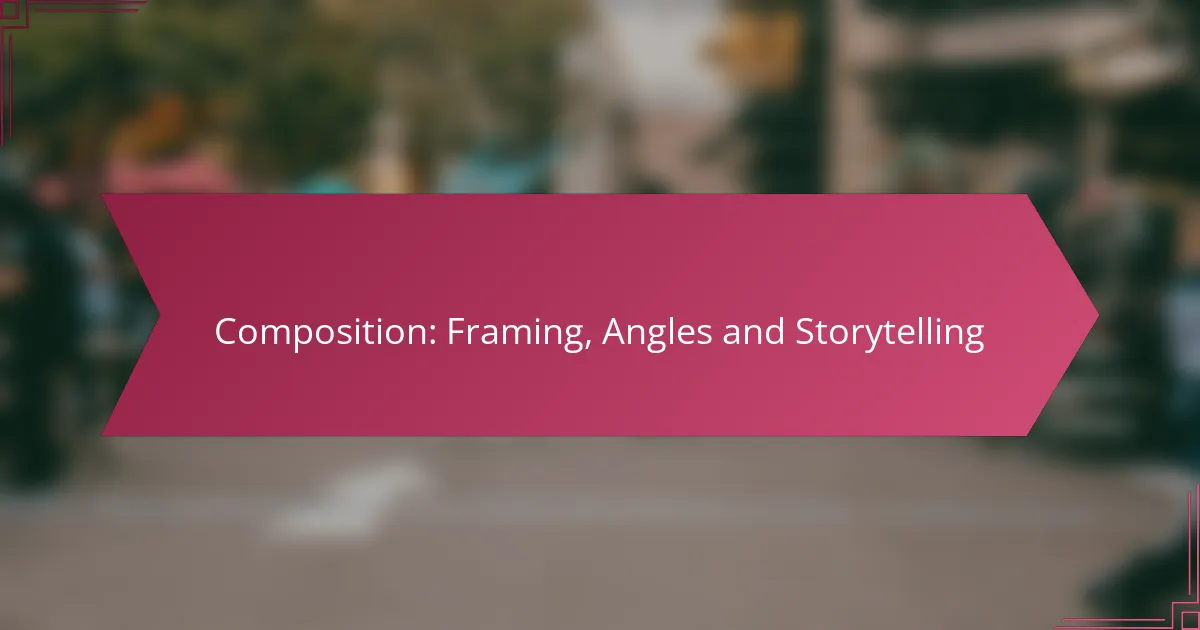Effective composition is vital for enhancing visual storytelling, utilizing techniques such as the Rule of Thirds and Leading Lines to draw attention to the subject. Angles further shape the viewer’s perception and emotional response, making them essential tools in visual communication. By mastering these elements, creators can guide the viewer’s eye and enrich the narrative experience.
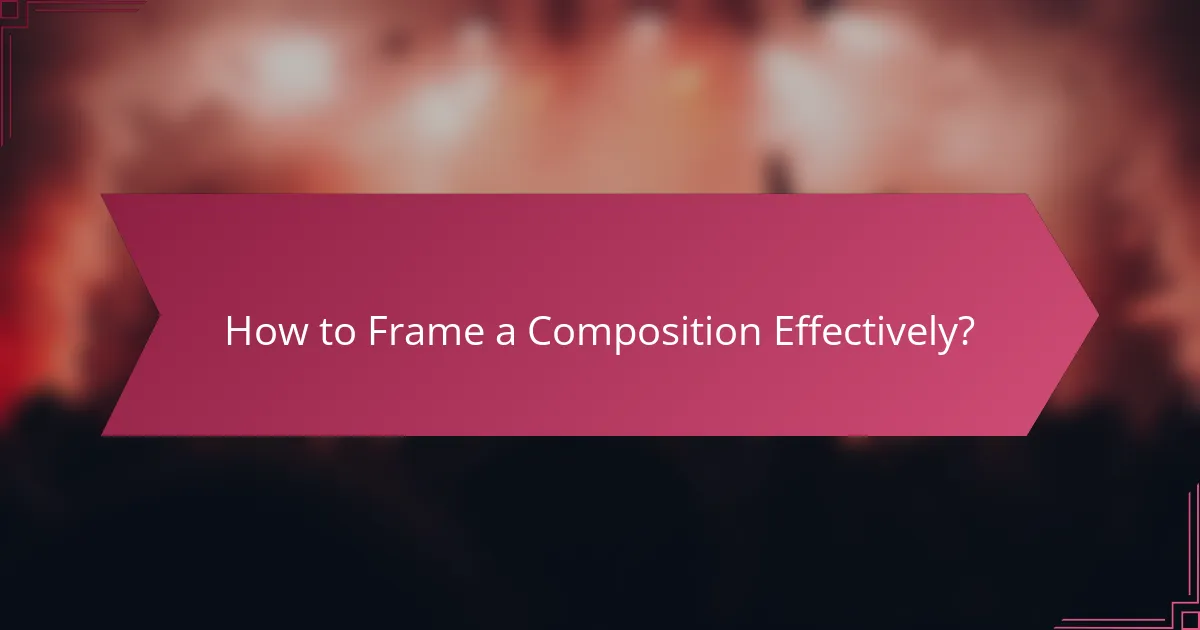
How to Frame a Composition Effectively?
Framing a composition effectively involves using specific techniques to enhance visual storytelling and draw attention to the subject. Key methods include the Rule of Thirds, Leading Lines, Framing Techniques, Negative Space Usage, and Symmetry and Balance, each contributing to a more engaging and coherent image.
Rule of Thirds
The Rule of Thirds is a fundamental guideline in composition that divides an image into nine equal parts using two horizontal and two vertical lines. Positioning key elements along these lines or at their intersections can create a more balanced and dynamic composition. For example, placing the horizon along the top or bottom third can enhance the sense of depth.
When applying this rule, consider breaking it occasionally for creative effect. Experiment with different placements to see how they affect the overall impact of your image.
Leading Lines
Leading Lines are natural lines within a scene that guide the viewer’s eye toward the main subject. These can be roads, rivers, or architectural elements that create a path for the viewer to follow. Utilizing leading lines can add depth and perspective, making the composition more engaging.
To effectively use leading lines, identify strong lines in your environment and position your camera to incorporate them into the frame. Ensure these lines lead directly to the focal point to maintain clarity and focus.
Framing Techniques
Framing Techniques involve using elements within the scene to create a ‘frame’ around the subject, drawing attention to it. This can include natural elements like trees or man-made structures like windows. By enclosing the subject, you can enhance its prominence and create a sense of context.
When employing framing techniques, ensure that the frame complements rather than distracts from the subject. Look for ways to use foreground elements to enhance depth and interest.
Negative Space Usage
Negative Space refers to the area surrounding the main subject in a composition. Effectively using negative space can emphasize the subject and create a minimalist aesthetic. This technique can help convey mood and focus the viewer’s attention where it matters most.
To utilize negative space, consider leaving ample space around your subject. This can create a sense of isolation or highlight the subject’s importance. Experiment with different amounts of negative space to find the right balance for your composition.
Symmetry and Balance
Symmetry and Balance in composition involve arranging elements so that they are visually harmonious. Symmetrical compositions can evoke a sense of order and stability, while asymmetrical balance can create tension and interest. Both approaches can be effective depending on the desired emotional impact.
When composing your shot, assess the visual weight of elements and aim for a pleasing arrangement. Use symmetry for formal subjects and asymmetry for dynamic scenes to enhance storytelling.
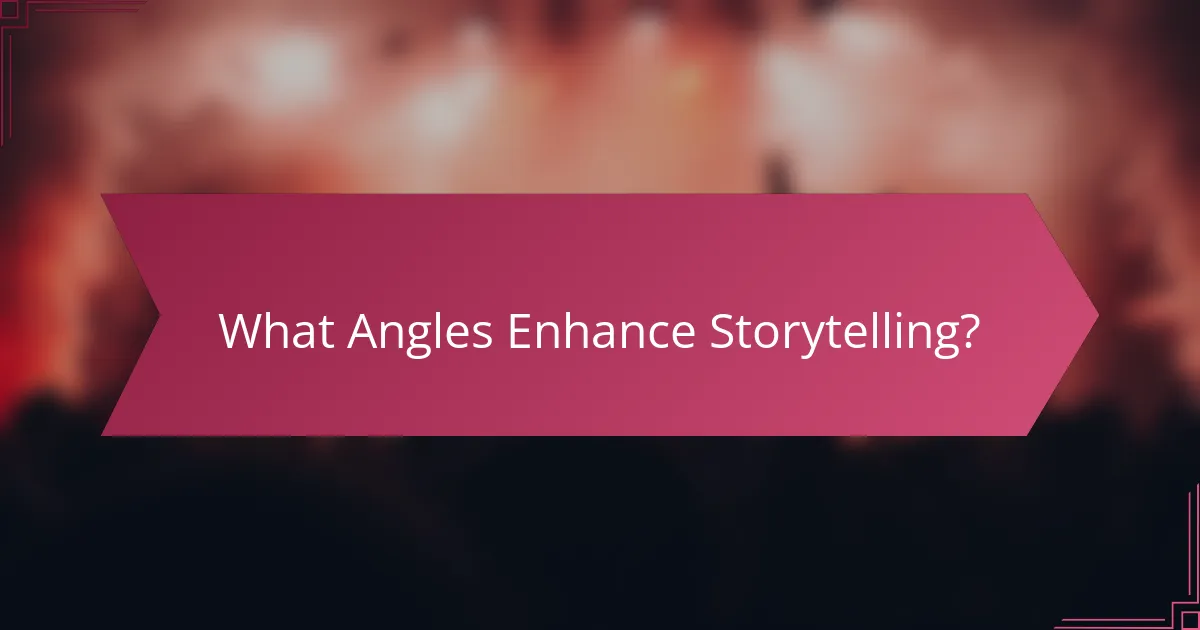
What Angles Enhance Storytelling?
Angles play a crucial role in storytelling by influencing the viewer’s perception and emotional response. Different camera angles can evoke distinct feelings and highlight various aspects of a narrative, making them essential tools for effective visual communication.
High Angle Shots
High angle shots are taken from above the subject, looking down. This perspective often makes the subject appear smaller, weaker, or more vulnerable, which can enhance themes of power dynamics in a story.
When using high angle shots, consider the emotional impact on the audience. For instance, filming a character from above during a moment of defeat can amplify their sense of helplessness. Aim for a subtle tilt to maintain a natural look while still conveying the intended emotion.
Low Angle Shots
Low angle shots are captured from below the subject, looking up. This angle can create a sense of power, dominance, or heroism, making the subject appear larger and more imposing.
To effectively use low angle shots, position the camera at knee level or lower to emphasize the subject’s stature. This technique is particularly effective in action scenes or when portraying a character’s triumph. However, avoid overusing this angle, as it can become cliché if not applied thoughtfully.
Bird’s Eye View
Bird’s eye view shots are taken directly overhead, providing a unique perspective that can reveal spatial relationships and context. This angle can create a sense of detachment or omniscience, allowing the audience to see the bigger picture.
When employing a bird’s eye view, consider how it can enhance the narrative. For example, it can be used to depict chaos in a crowded scene or to highlight the layout of a setting. Ensure that the composition remains clear, as clutter can distract from the intended message.
Worm’s Eye View
Worm’s eye view shots are taken from ground level, looking up, often emphasizing the height of structures or characters. This perspective can evoke feelings of awe or insignificance, drawing attention to the scale of the environment.
Utilize worm’s eye view shots to create dramatic effects, especially in scenes involving towering buildings or imposing figures. Be mindful of lighting, as shadows can enhance the mood but may also obscure details. Experiment with angles to find the most compelling composition for your story.
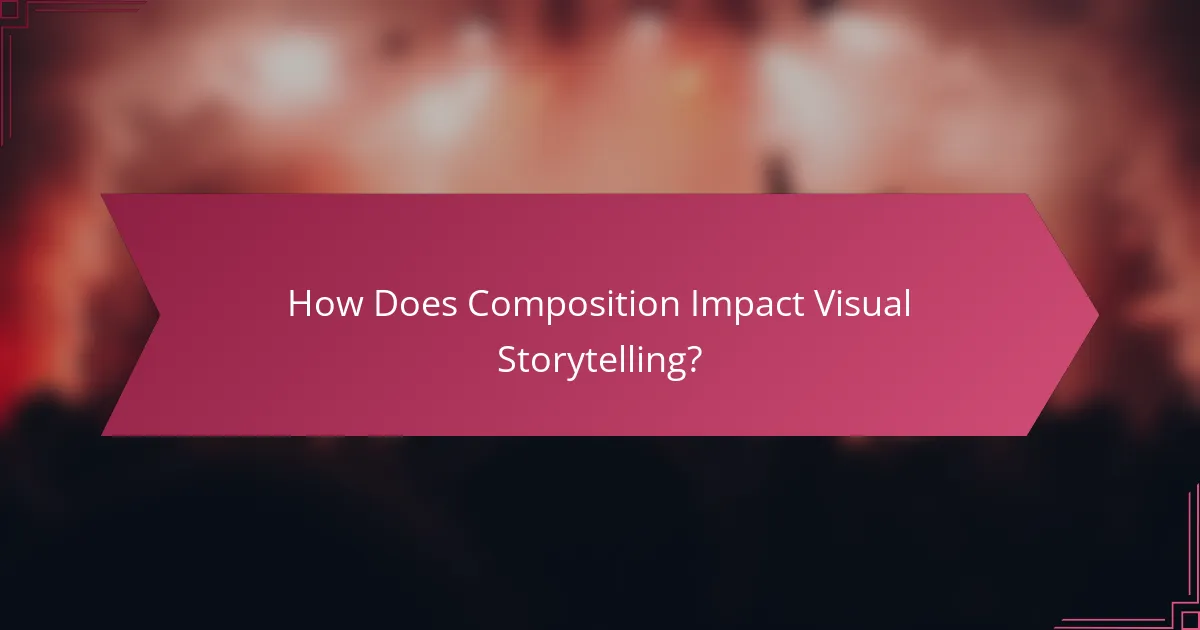
How Does Composition Impact Visual Storytelling?
Composition significantly influences visual storytelling by guiding the viewer’s eye and shaping emotional responses. Effective use of framing, angles, and spatial relationships can enhance the narrative and deepen engagement with the content.
Emotional Engagement
Emotional engagement in visual storytelling is achieved through strategic composition choices. For instance, close-up shots can evoke intimacy, while wide shots may create a sense of isolation or grandeur. Understanding the emotional tone of your story helps in selecting the right composition techniques.
Consider using contrasting colors and lighting to amplify feelings. A warm color palette can evoke comfort, while cooler tones may suggest tension. Always align your composition with the emotional journey you wish to convey.
Narrative Clarity
Composition plays a crucial role in ensuring narrative clarity by organizing visual elements in a way that guides the viewer through the story. Clear focal points, such as a character or an object, help direct attention and maintain focus on the narrative’s key elements.
Utilize leading lines and the rule of thirds to create a balanced composition that enhances understanding. Avoid cluttered frames that can confuse the viewer; simplicity often aids in clearer storytelling.
Character Focus
Focusing on characters through composition can enhance their significance in the story. Techniques like framing characters within the environment or using depth of field can draw attention to their emotions and actions. This helps the audience connect with the characters on a deeper level.
When composing shots, consider the character’s placement within the frame. A character positioned off-center can create tension, while a centered character may convey stability. Adjust your composition based on the character’s role and the desired impact on the audience.
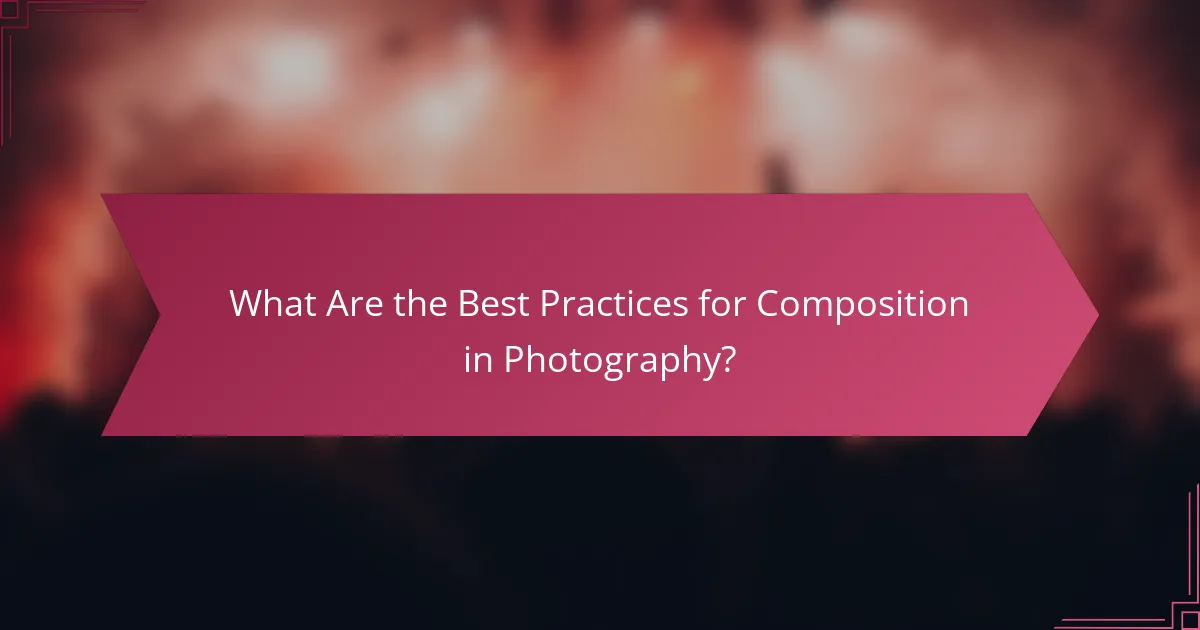
What Are the Best Practices for Composition in Photography?
Effective composition in photography involves arranging elements within the frame to create visually appealing and meaningful images. Key practices include the use of light and shadow, color theory, and depth of field control, each contributing to the overall storytelling of the photograph.
Use of Light and Shadow
Light and shadow are fundamental to photography, influencing mood and depth. Utilize natural light during golden hours—shortly after sunrise or before sunset—to achieve soft, warm tones. Experiment with shadows to add dimension; for instance, side lighting can create dramatic contrasts that enhance textures.
Consider the direction of light when framing your shot. Backlighting can produce silhouettes, while front lighting reveals details. Avoid harsh midday sun, as it can create unflattering shadows and highlights. Instead, seek shaded areas or overcast days for even lighting.
Color Theory Application
Understanding color theory enhances visual impact and emotional resonance in photography. Use complementary colors to create striking contrasts, or analogous colors for a harmonious feel. For example, pairing blue with orange can draw attention to the subject while evoking energy.
Be mindful of color temperature; warmer tones can evoke feelings of warmth and comfort, while cooler tones may suggest calmness or detachment. When composing your shot, consider how the colors interact and the story they convey. A well-chosen color palette can significantly enhance the narrative of your image.
Depth of Field Control
Depth of field (DoF) refers to the range of distance that appears sharp in an image. A shallow DoF, achieved by using a wide aperture (like f/1.8), isolates the subject from the background, making it stand out. This technique is effective for portraits and macro photography.
Conversely, a deep DoF, obtained with a narrow aperture (like f/16), keeps more of the scene in focus, which is ideal for landscapes. When composing, consider your subject and the desired context; adjusting your aperture can dramatically change the viewer’s focus and interpretation of the image.
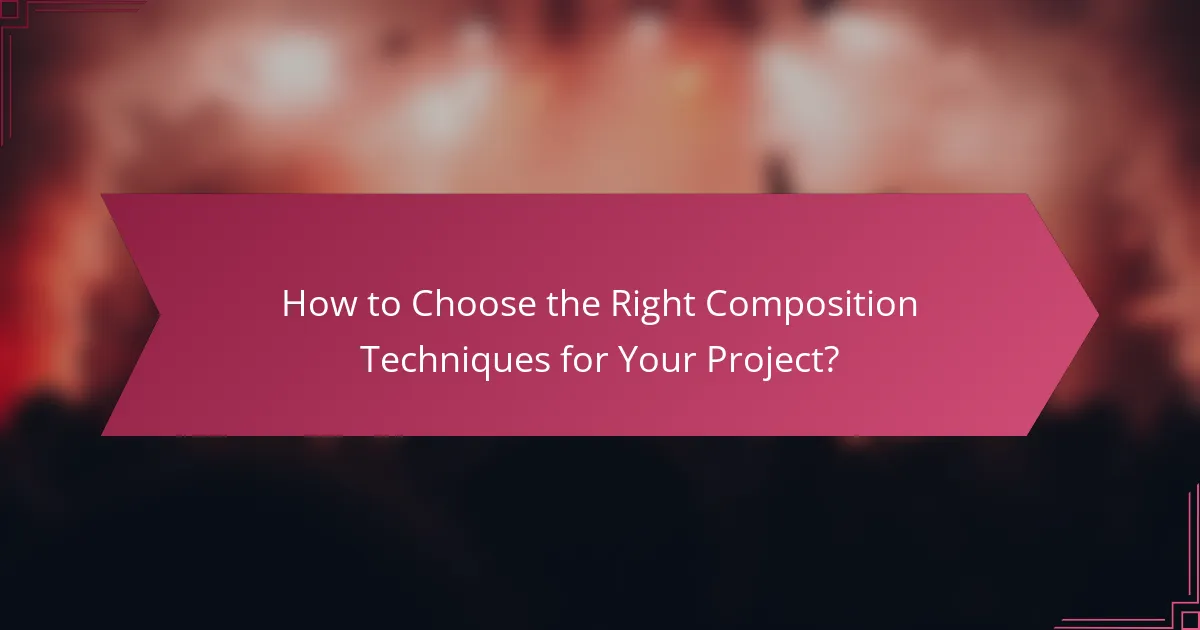
How to Choose the Right Composition Techniques for Your Project?
Selecting the right composition techniques involves understanding your project’s goals and the story you want to tell. Consider factors such as the intended audience, the medium of presentation, and the emotional impact you wish to achieve.
Project Goals Assessment
Assessing your project goals is crucial for determining the appropriate composition techniques. Start by defining the primary message or emotion you want to convey. This clarity will guide your choices in framing, angles, and overall visual storytelling.
Consider the context of your project. For instance, a documentary may benefit from naturalistic angles and compositions that emphasize authenticity, while a commercial project might require more stylized techniques to evoke specific emotions. Think about how each technique aligns with your objectives.
To effectively assess your goals, create a checklist of key elements such as target audience, desired emotional response, and the narrative arc. This structured approach will help you make informed decisions about the composition techniques that best serve your project.
